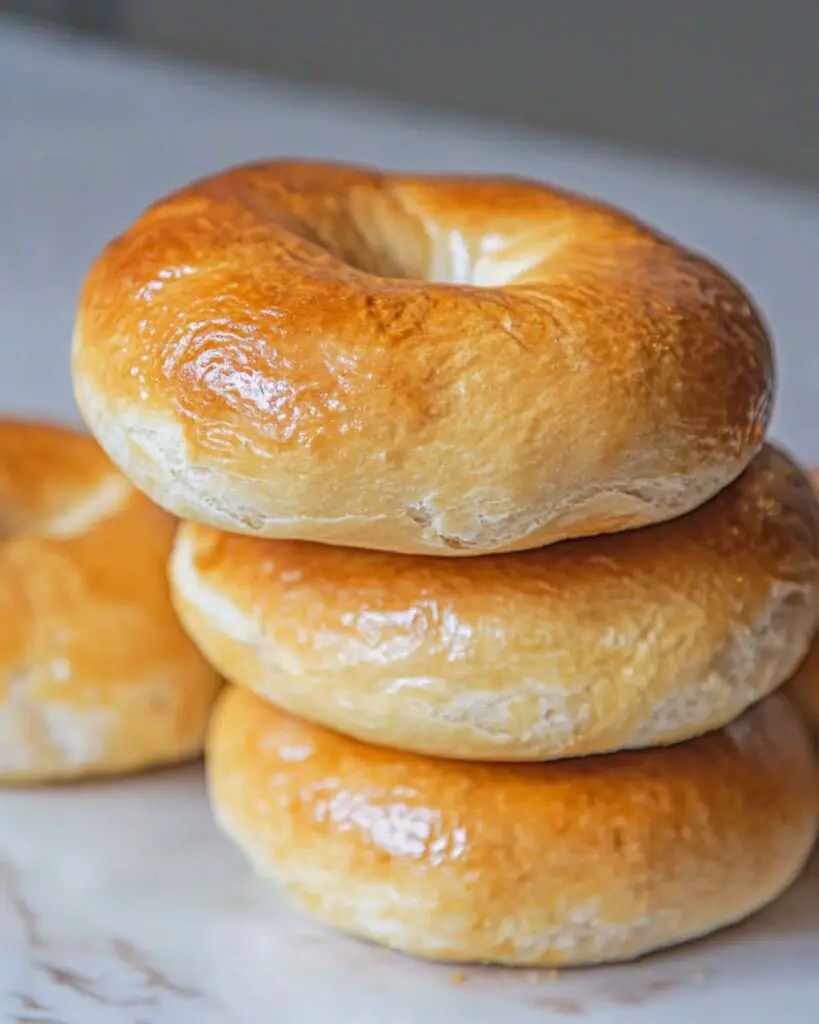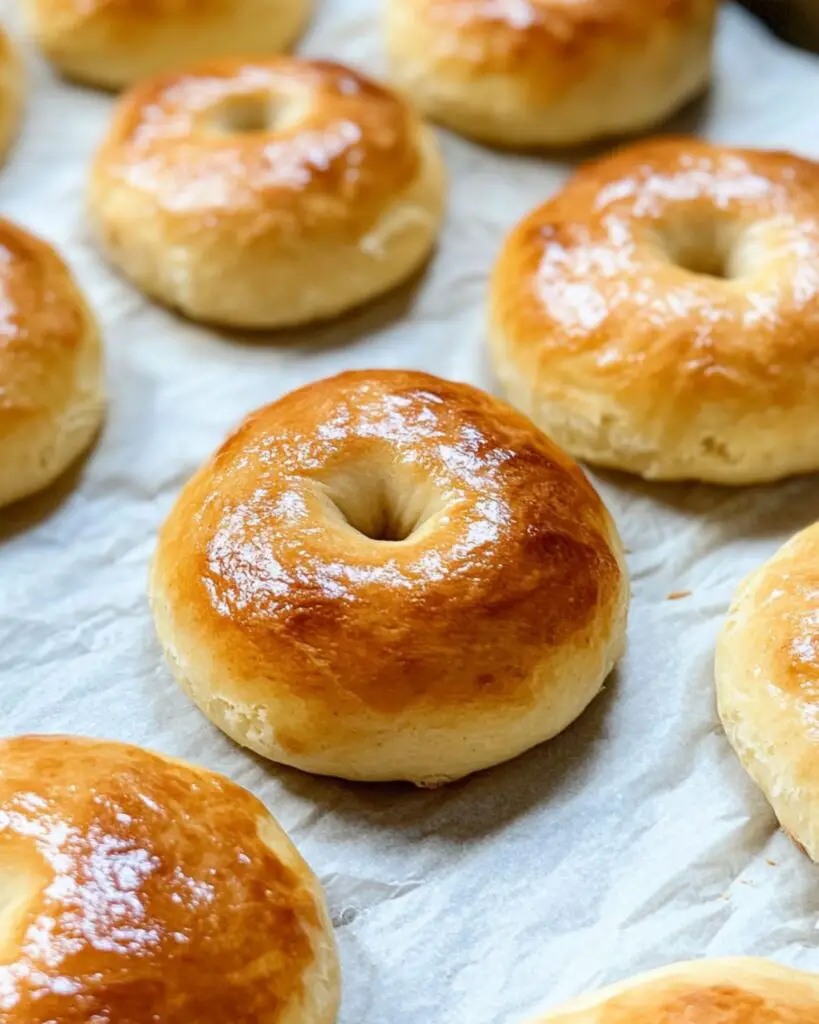This incredible overnight sourdough bagel recipe delivers chewy, flavorful bagels with that perfect, glossy crust—all with minimal hands-on time. The long fermentation creates deep flavor while you sleep, making these bagels both easier and tastier than store-bought versions. Perfect for weekend baking projects when you want impressive results without complicated techniques!
Why You’ll Love This Recipe
- Make-Ahead Magic: Most of the work happens while you sleep! Mix the dough in the evening, and you’ll be most of the way to fresh bagels by morning.
- Forgiving Process: This dough is remarkably resilient—even with varied proofing times, you’ll still get excellent results. Perfect for bakers of all skill levels.
- Authentic Flavor: The overnight fermentation creates that distinctive sourdough tang that pairs beautifully with the chewy bagel texture.
- Customizable: Once you master the basic recipe, you can add any toppings you like—everything seasoning, sesame seeds, poppy seeds, or keep them plain for versatile serving options.
Ingredients You’ll Need
- Sourdough Starter: The heart of this recipe—provides natural leavening and that distinctive tangy flavor. Can use active or discard starter for the initial feeding.
- Bread Flour: Essential for developing strong gluten, giving your bagels that perfect chewy texture. All-purpose flour won’t provide the same structure.
- Water: The hydration level is adjustable depending on your climate and season—use less in summer, more in winter to get that perfect playdough consistency.
- Honey: Adds a touch of sweetness but also helps feed the yeast and promotes beautiful browning during baking.
- Sea Salt: Enhances flavor and controls fermentation. Don’t skip this—unsalted bagels taste flat and uninteresting.
- Baking Soda: Added to the boiling water to create that distinctive alkaline environment that gives bagels their shiny, chewy crust.
- Brown Sugar: Also added to the boiling water to promote browning and add a subtle sweetness to the crust.
Note: You’ll find the complete list of ingredients, along with their exact measurements, in the printable recipe card at the bottom of this post.
Variations
Flavor Additions
- Cinnamon Raisin: Mix 1 tablespoon cinnamon and 3/4 cup raisins into the dough during the initial mixing.
- Garlic & Herb: Add 2 tablespoons dried garlic and 1 tablespoon Italian herbs to the dough.
- Jalapeño Cheddar: Fold in 1/2 cup shredded cheddar and 2 tablespoons diced jalapeños during shaping.
Topping Ideas
- Everything Bagel: Mix equal parts poppy seeds, sesame seeds, dried garlic, dried onion, and coarse salt.
- Seeded: Top with sesame seeds, poppy seeds, or sunflower seeds before baking.
- Sweet Option: Sprinkle with cinnamon sugar after boiling for a dessert-like variation.
Note: Add toppings immediately after boiling while the bagels are still wet so they stick properly.
How to Make Sourdough Bagels
Step 1: Feed Your Starter
In the morning of day one, combine 13g sourdough starter with 64g bread flour and 64g water in a jar. Mix well and leave at room temperature for 10-12 hours until bubbly and doubled in size.
Step 2: Mix Your Dough
Before bedtime, when your starter is at its peak, combine 113g active starter, 560g bread flour, 236-276g water (starting with the lower amount), 20g honey, and 10g sea salt in your stand mixer. Mix for about 5 minutes until you achieve a smooth, playdough-like consistency. Add more water only if you see dry flour after the first minute of mixing.
Step 3: Overnight Fermentation
Cover your dough and let it rest at room temperature (around 75°F/24°C) for 10-13 hours. This long, slow fermentation develops flavor while you sleep. Don’t worry if it doubles or even triples in size—this recipe is forgiving!
Step 4: Shape Your Bagels
In the morning, divide your dough into 75g portions (or larger if you prefer bigger bagels) and roll each into smooth balls. Place them on a parchment-lined baking sheet. Then, poke a hole in the center of each ball and gently stretch to form the classic bagel shape.
Step 5: Second Rise
Cover the shaped bagels with plastic wrap and let them rise for 5-6 hours at room temperature until noticeably puffy. This step is crucial for developing proper texture.
Step 6: Boil and Bake
Preheat your oven to 425°F (220°C). Bring a large pot of water to boil and add the baking soda and brown sugar. Boil each bagel for 2 minutes per side—this sets the crust and creates that distinctive bagel texture. Top as desired, then bake for 18-22 minutes until golden brown.
Pro Tips for Making the Recipe
- Dough Consistency: Aim for a firm, playdough-like texture. Too wet, and your bagels will flatten; too dry, and they’ll be dense.
- Parchment Squares: Cut individual parchment squares for each bagel before the second rise. This makes transferring them to the boiling water much easier without deflating them.
- Room Temperature Matters: The fermentation times are based on approximately 75°F (24°C). If your kitchen is significantly cooler or warmer, you’ll need to adjust accordingly.
- Boiling Time: Don’t skip or shorten the boiling step—those 2 minutes per side are essential for developing the characteristic chewy crust.
- Shaping Technique: When forming the hole, don’t tear the dough—gently stretch it to maintain the dough’s structure and strength.
How to Serve

Classic Pairings
Serve your fresh bagels with cream cheese, lox, thinly sliced red onion, and capers for an iconic breakfast combination.
Breakfast Sandwich
Split and toast your bagels, then layer with a fried egg, cheese, and your choice of bacon or avocado for a hearty breakfast.
Sweet Options
For a simpler approach, split your bagels while still slightly warm and spread with butter and honey or your favorite jam.
Make Ahead and Storage
Storing Freshly Baked Bagels
Store completely cooled bagels in a paper bag at room temperature for 1-2 days to maintain their crusty exterior. For longer storage, move to a sealed container, where they’ll soften slightly but remain delicious for up to 4 days.
Freezing
These bagels freeze beautifully! Once completely cooled, place them in a freezer bag and freeze for up to 3 months. Thaw at room temperature or toast directly from frozen.
Reheating
For the best texture after storage, slice and toast your bagels. If frozen, you can toast directly from frozen, just add an extra minute to your toasting time.
FAQs
Can I use all-purpose flour instead of bread flour?
While you technically can use all-purpose flour, your bagels won’t have the same chewy texture. Bread flour has higher protein content that develops stronger gluten, giving bagels their characteristic chew. If you must substitute, add 1 tablespoon vital wheat gluten per cup of all-purpose flour to improve the structure.
My kitchen is cold. How should I adjust the fermentation time?
In a cooler kitchen (below 70°F/21°C), extend both the bulk fermentation and the second rise by 2-3 hours. Alternatively, place your dough in a turned-off oven with just the light on to create a slightly warmer environment. The dough should visibly increase in size and feel puffy before moving to the next step.
Can I skip the boiling step?
No, boiling is essential for authentic bagels. This step pre-gelatinizes the starches on the surface, creating that distinctive chewy, shiny crust. Without boiling, you’d essentially have bread shaped like bagels, lacking their defining texture.
Why did my bagels deflate during boiling?
Deflating usually occurs when bagels are over-proofed or handled too roughly. Make sure your shaped bagels are puffy but not overly airy before boiling. Using the parchment square method mentioned in the recipe helps tremendously with gentle handling during transfer to the boiling water.
Final Thoughts
These overnight sourdough bagels transform a seemingly complex bakery item into a totally doable home baking project. The hands-off nature makes them perfect for weekend mornings, and the amazing flavor from the slow fermentation will have you swearing off store-bought versions for good! Give yourself this gift of fresh, warm bagels—your kitchen will smell amazing, and the sense of accomplishment that comes with mastering these is absolutely worth the minimal effort they require.
Print
Easy, Overnight Sourdough Bagel Recipe
- Prep Time: 30 minutes
- Cook Time: 32 minutes
- Total Time: 18 hours
- Yield: 8-10 bagels
- Category: Bread
- Method: Baking
- Cuisine: American
- Diet: Vegetarian
Description
Enjoy tangy, chewy homemade sourdough bagels with this easy overnight recipe. Minimal hands-on time makes it perfect for beginners—simply feed your starter, mix the dough, and let time do most of the work. The result is flavorful bagels with a crisp golden crust, perfect for breakfast or sandwiches.
Ingredients
Feed Your Starter
- 13 g sourdough starter (active or discard)
- 64 g bread flour
- 64 g water
Main Dough
- 113 g active starter
- 560 g bread flour
- 236–276 g water (start with 236 g; add more as needed)
- 20 g honey
- 10 g sea salt
For the Boiling Water
- 2 tsp baking soda
- 2 tbsp brown sugar
Instructions
- Feed Your Starter: In the morning, mix 13 g sourdough starter, 64 g bread flour, and 64 g water in a clean jar or bowl. Allow the starter to rise at room temperature (about 75°F/24°C) for 10-12 hours, until peaked and bubbly. This will prepare enough active starter for your bagels.
- Mix the Main Dough: In a large bowl or stand mixer, combine 113 g of the active starter, 560 g bread flour, 236 g water (add more if dough looks dry), 20 g honey, and 10 g sea salt. Knead on medium speed for about 5 minutes, until the dough is smooth and pliable like playdough. Adjust water amount depending on dough texture and ambient temperature.
- Bulk Fermentation: Cover the bowl with plastic wrap or a damp towel and leave the dough to ferment at room temperature overnight (10-13 hours at 75°F/24°C). The dough should double or even triple in volume.
- Divide and Shape: The next morning, divide the dough into 75 g pieces (or larger if preferred). Roll each piece into a tight, smooth ball and place onto a parchment-lined baking sheet.
- Shape the Bagels: Working with one ball at a time, poke a hole through the center with your finger, then gently stretch and roll to create the classic bagel shape. Optionally, place each bagel on its own square of parchment for easier transfer later.
- Second Rise: Cover the shaped bagels loosely with plastic wrap and let them rest at room temperature (75°F/24°C) for 5-6 hours, until puffy and risen. The time can be extended up to 9 hours if needed.
- Boil the Bagels: Preheat oven to 425°F (220°C). Bring a large pot of water to a boil. Add 2 tsp baking soda and 2 tbsp brown sugar. Boil bagels (in batches of 4) for 2 minutes per side, then return to the parchment-lined baking sheet.
- Bake: Add any desired toppings to the bagels. Bake for 18-22 minutes until golden brown and cooked through. Cool on a wire rack before slicing and serving.
Notes
- Use a kitchen scale for best results and accuracy with ingredient measurements.
- Total rising time may vary depending on your room temperature.
- Adjust the water in the dough depending on your kitchen’s humidity and season.
- Baking soda and brown sugar in the boiling water help create the classic bagel crust and color.
- Freeze leftover bagels for up to 1 month; slice before freezing for easy toasting.
- Toppings such as sesame seeds, poppy seeds, or everything seasoning can be added before baking after boiling.
Nutrition
- Serving Size: 1 bagel (about 90g)
- Calories: 210
- Sugar: 3g
- Sodium: 390mg
- Fat: 0.5g
- Saturated Fat: 0g
- Unsaturated Fat: 0.5g
- Trans Fat: 0g
- Carbohydrates: 44g
- Fiber: 2g
- Protein: 7g
- Cholesterol: 0mg









